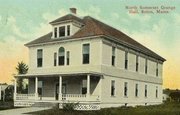Grange movement
|
|
The Grange movement in the United States was a farmers' movement involving the affiliation of local farmers into area "granges" to work for their political and economic advantages. The official name of the National Grange is the Patrons of Husbandry. Today they might be considered a special interest group. Founded after the Civil War, it flourished toward to the end of the 19th century. Many small rural communities in New England, the Midwest and West still have an old "Grange Hall" standing on Main Street. The word "grange" comes from a Latin word for grain, and is related to a "granary" or, more generically, a farm.
In 2005, the Grange claims a membership of 300,000 with organizations in 3,600 communities in 37 states. They occupy a headquarters in downtown Washington, D.C., an 11-story building they had built in 1960.
History
The Founders of the Grange were: Oliver Hudson Kelley, William Saunders, Francis M. McDowell, John Trimble, Aaron B. Grosh, John R. Thompson, William M. Ireland and Caroline A. Hall.
Originally founded in Washington, D.C. in 1867 as a social and educational organization borrowing ritualistic overtones from Freemasonry, membership in the Grange increased dramatically from 1873 (200,000) to 1875 (858,050) as many of the state and local granges adopted non-partisan political resolutions, especially regarding the regulation of railroad transportation costs. Rapid growth infused the national organization with money from dues, and many local granges established consumer co-operatives, initially supplied by the wholesaler Aaron Montgomery Ward. Poor fiscal management at both the national and local levels of the Grange led to a quick demise of the organization's new prosperity.
Stamp-national_grange.jpg
In the middle of the 1870s, the Granger movement was successful in fighting the perceived monopoly of the railroads and what were seen to be the exploitative rates of grain warehouses. The peak of their political power was marked by their success in Munn v. Illinois, which held that the grain warehouses were a "private utility in the public interest," and therefore could be regulated by public law (see references below, "The Granger Movement"). When other political parties took up the political causes of the Grange movement, it began to revert to being a largely social group. This is a likely source of its diminishing membership in later years — by 1880 membership had dropped to 124,420.
The monument to the founding of the Grange is claimed to be the only private momument on the National Mall in Washington, D.C.[1] (http://www.nationalgrange.org/about/history.html)
External links
- "A Short History of the Order of Patrons of Husbandry, also known as the National Grange," by Charles P. Gilliam (http://www.geocities.com/cannongrange/cannon_nationalhistory.html)
- Official Website of the National Grange of the Order of Patrons of Husbandry (http://www.nationalgrange.org/home.htm)
- Background, History, Ritual and Emblems of the Grange (http://mill-valley.freemasonry.biz/marin-fraternities-02.htm#Patrons%20of%20Husbandry)
References
Template:Web reference Template:Web reference Template:Web reference

